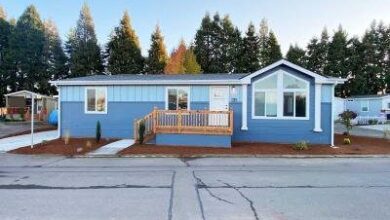Prefab Shipping Container Homes: Unique and Sustainable Living
Prefab Shipping Container Homes – Shipping container homes have gained tremendous popularity in recent years as a unique, eco-friendly, and cost-effective solution to housing. These innovative dwellings are constructed using repurposed shipping containers, offering a sustainable alternative to traditional homes. In this comprehensive guide, we will explore the world of prefab shipping container homes in great detail, covering everything from their benefits and design options to the construction process, maintenance, and the future of this exciting housing trend. Whether you are considering living in a container home or simply intrigued by this emerging architectural phenomenon, this article will provide you with all the information you need to make an informed decision and embark on your container home journey.
Benefits of Prefab Shipping Container Homes
Container homes offer numerous advantages that make them an appealing choice for those seeking an affordable, versatile, and eco-friendly housing solution. Let’s delve into some of the key benefits:
Affordability
One of the most compelling reasons to consider a prefab shipping container home is its affordability. Traditional home construction can be costly, but repurposing shipping containers significantly reduces the expenses associated with building materials. Moreover, container homes require less time and labor for construction, further driving down the overall costs.
Versatility
Shipping containers come in various sizes and can be easily modified and combined to create a wide range of living spaces. Whether you desire a compact and cozy single-container dwelling or a spacious multi-story home, the versatility of shipping containers allows you to design a living space that suits your needs and preferences.
Eco-Friendliness
One of the most compelling aspects of prefab shipping container homes is their contribution to sustainability. By repurposing shipping containers, these homes give a second life to discarded materials that would otherwise contribute to landfill waste. Additionally, using containers reduces the demand for traditional building materials, cutting down on deforestation and the carbon footprint associated with manufacturing new construction materials.
Rapid Construction
The construction process for prefab shipping container homes is considerably faster compared to traditional homes. Since the containers are already built, the main focus is on modifying and assembling them to create a functional living space. This streamlined construction process allows you to move into your container home much sooner than with conventional housing.
Design Options and Floor Plans
Prefab shipping container homes offer endless design possibilities, as these versatile containers can be transformed into unique and personalized living spaces. Let’s explore some design options and floor plans to inspire your container home dreams:
Single-Container Dwellings
A single-container dwelling is an ideal choice for individuals or small families seeking a compact and efficient living space. With careful planning and creative design, a single container can be transformed into a cozy, fully functional home. Consider integrating space-saving solutions such as lofted beds, foldable furniture, and multipurpose storage to maximize the use of limited floor space.
Multiple-Container Homes
If you desire a larger living space or have a growing family, multiple-container homes provide ample room for customization. By combining two or more containers, you can create multi-bedroom houses, spacious living areas, and even separate sections for work or recreation. The flexibility of container arrangements allows you to design a home that perfectly suits your lifestyle.
Multi-Story Structures
While single-level container homes are popular, multi-story structures offer an opportunity to maximize living space on a smaller footprint. By stacking containers vertically, you can create multiple floors, each serving a specific purpose. Consider dedicating the ground floor to communal spaces such as the kitchen, dining area, and living room, while allocating upper levels to private bedrooms and workspaces.
Customized Layouts
One of the greatest advantages of container homes is the ability to customize layouts according to your preferences. Whether you desire an open-concept design or prefer more defined rooms, containers can be modified to accommodate your needs. With the help of architects, designers, and container home specialists, you can create a layout that optimizes space and flow within your container home.
Construction Process
Understanding the construction process of prefab shipping container homes is essential to ensure a successful and efficient project. Let’s break down the step-by-step process involved:
Site Preparation
The first step in constructing a container home is to prepare the site where it will be located. This involves clearing the area, leveling the ground, and ensuring proper drainage to prevent any potential water-related issues. It is important to consult with professionals to ensure the site is suitable for building and complies with local regulations.
Foundation Installation
Next, the foundation for the container home needs to be established. There are various foundation options to consider, such as concrete slabs, piers, or even helical piles. The choice of foundation depends on factors like soil conditions, local building codes, and the intended use of the container home. It is crucial to consult with a structural engineer or foundation specialist to determine the most suitable foundation for your specific project.
Container Modifications
Once the foundation is in place, the containers can be modified according to the desired design and layout. This includes cutting openings for doors, windows, and any additional fixtures, as well as reinforcing the containers to ensure structural integrity. It is important to work with experienced professionals who understand the complexities of container modification to ensure the safety and durability of your home.
Container Assembly
After the containers have been modified, they can be assembled on the foundation. This involves lifting and positioning the containers using heavy machinery or cranes. The containers are securely attached to each other and the foundation, ensuring stability and structural integrity. Proper sealing and insulation are essential during this stage to create a comfortable and energy-efficient living space.
Interior Finishing
With the containers in place, the interior finishing work can begin. This includes installing electrical and plumbing systems, insulation, drywall, flooring, and other interior finishes. The choice of materials and finishes will depend on personal preferences and the desired aesthetic. It is advisable to work with professionals for the installation of electrical and plumbing systems to ensure compliance with safety standards.
Exterior Finishing
The exterior of a container home can be finished in various ways, depending on the desired look and level of maintenance required. Options include painting, cladding, or leaving the containers exposed for an industrial aesthetic. It is important to choose finishes that not only enhance the visual appeal but also protect the containers from external elements and extend their lifespan.
Utilities Connection
Connecting utilities such as water, electricity, and sewage to your container home is a crucial step in making it fully functional. This involves coordinating with local service providers to ensure the proper installation of utility connections. It is essential to comply with local building codes and regulations to ensure the safety and efficiency of these essential systems.
Insulation and Energy Efficiency
Proper insulation is key to creating a comfortable and energy-efficient living environment in a shipping container home. Let’s explore different insulation methods and materials to ensure your container home is well-insulated:
Spray Foam Insulation
Spray foam insulation is a popular choice for container homes due to its excellent thermal performance and air sealing properties. It is applied as a liquid and expands to fill and seal gaps and cavities within the container walls. Spray foam insulation helps maintain a consistent temperature inside the home, reducing the need for excessive heating or cooling.
Rigid Foam Insulation
Rigid foam insulation panels can be attached to the interior or exterior of container walls. These panels have high insulating properties and provide an additional layer of protection against temperature fluctuations. Rigid foam insulation is available in various thicknesses, allowing you to customize the level of insulation based on your climate and energy efficiency goals.
Insulated Shipping Containers
If you prefer a hassle-free insulation option, you can opt for pre-insulated shipping containers. These containers are specifically designed with insulation material already installed during the manufacturing process. While they may be more expensive than non-insulated containers, they can save time and effort during the construction phase.
Window and Door Insulation
In addition to insulating the container walls, it is essential to pay attention to the insulation of windows and doors. Properly insulated windows and doors help prevent heat transfer and air leakage, contributing to overall energy efficiency. Look for windows and doors with double or triple glazing and weatherstripping to maximize insulation.
Ventilation and Moisture Control
While insulation is crucial, maintaining proper ventilation is equally important in a container home. Adequate ventilation helps control moisture levels and prevents mold and condensation issues. Consider installing mechanical ventilation systems, such as energy recovery ventilators (ERVs) or heat recovery ventilators (HRVs), to ensure a constant supply of fresh air while minimizing energy loss.
Plumbing and Electrical Systems
Proper installation of plumbing and electrical systems is vital for the functionality and safety of your container home. Let’s explore the key considerations for these essential utilities:
Plumbing Systems
Designing and installing plumbing systems in a container home requires careful planning and adherence to local building codes. Some key considerations include:
Water Supply
When it comes to water supply in a container home, you have a few options to consider. You can connect your home to a municipal water supply if available, or you can opt for a well or rainwater harvesting system. Depending on your location and water needs, you may need to install water storage tanks or filtration systems to ensure a reliable and safe water supply.
Drainage
Proper drainage is essential to ensure the efficient removal of wastewater from your container home. This involves installing a system of pipes, drains, and septic tanks or connecting to a municipal sewage system. It is crucial to consult with a professional plumber to ensure that the drainage system meets local regulations and effectively handles the waste generated in your home.
Hot Water Systems
Hot water is a necessity in any home, including container homes. You can choose from various options for hot water supply, such as traditional water heaters, tankless water heaters, or even solar water heating systems. Consider factors like energy efficiency, space availability, and your specific hot water needs when selecting the most suitable system for your container home.
Electrical Systems
Designing and installing electrical systems in a container home requires careful planning to ensure safety and compliance with electrical codes. Some key considerations include:
Power Source
Decide on the power source for your container home. You can choose to connect to the local power grid or opt for alternative energy sources such as solar panels or wind turbines. Off-grid container homes often combine solar power with battery storage to provide a reliable and eco-friendly power supply.
Wiring and Outlets
The wiring and outlets in your container home should be installed by a licensed electrician to ensure compliance with electrical codes and safety standards. Plan the location and number of outlets based on your power needs and the layout of your home. Consider incorporating USB outlets, dimmer switches, and energy-efficient lighting options to enhance functionality and energy conservation.
Electrical Panel
An electrical panel, also known as a distribution board or breaker box, is a crucial component of your home’s electrical system. This panel houses the circuit breakers or fuses that control and distribute electricity throughout your home. Consult with an electrician to determine the appropriate size and capacity of the electrical panel based on your power requirements.
Backup Power Systems
Consider installing a backup power system to ensure uninterrupted power supply during outages. This can be achieved through the use of battery storage systems or backup generators. Backup power systems are particularly beneficial for off-grid container homes or areas prone to frequent power disruptions.
Interior Design and Décor
The interior design of your shipping container home allows you to express your personal style while maximizing functionality and comfort. Let’s explore some key considerations for designing the interior of your container home:
Space Optimization
Due to the limited square footage of container homes, it is essential to prioritize space optimization. Consider utilizing clever storage solutions such as built-in shelves, under-bed storage, and multi-functional furniture. Maximize vertical space by incorporating lofted beds or mezzanine levels, and use open-concept layouts to create the illusion of a larger living area.
Natural Light
Since containers are typically narrow and have limited windows, maximizing natural light is crucial for creating a bright and inviting interior. Consider adding large windows, skylights, or glass doors to allow ample natural light to flow into your home. Additionally, lighter paint colors and reflective surfaces can help enhance the feeling of brightness and openness.
Aesthetics and Finishes
When it comes to aesthetics, the design possibilities for container homes are vast. You can embrace the industrial look of the containers by leaving the walls exposed or opt for finishes such as paint, wallpaper, or cladding to create a more traditional or contemporary appearance. Choose materials and finishes that reflect your personal style and create a cohesive and inviting atmosphere.
Functional Zones
Organize your container home into functional zones to optimize the use of space. Designate specific areas for living, dining, cooking, and sleeping, and consider incorporating flexible spaces that can serve multiple purposes. Use rugs, room dividers, or furniture placement to visually separate different zones while maintaining an open and cohesive feel.
Climate Considerations
Take into account the climate in which your container home is located when designing the interior. Consider insulation levels, ventilation, and shading options to ensure comfort throughout the year. In colder climates, consider incorporating additional heating sources such as radiant floor heating or efficient wood-burning stoves. In warmer climates, prioritize cross-ventilation and shading strategies to keep the interior cool.
Permits and Regulations
Before embarking on your container home project, it is crucial to familiarize yourself with local permits and regulations. Here are some key factors to consider:
Zoning and Building Codes
Research the zoning regulations and building codes specific to your location to ensure that container homes are permitted in your area. Check if there are any restrictions on the use of shipping containers for residential purposes, minimum square footage requirements, setback regulations, or design guidelines. Consult with local authorities or a building professional to ensure compliance.
Building Permits
Obtaining the necessary building permits is essential to ensure that your container home project is legal and meets all safety requirements. The permit process typically involves submitting detailed plans, specifications, and engineering calculations for review. Work with an architect or designer experienced in container home construction to help navigate the permit application process.
Utilities and Services
Check with local utility providers to determine the availability of water, electricity, and sewage connections in the area where you plan to build your container home. Ensure that the necessary infrastructure is in place or explore alternative options, such as off-grid systems or self-sufficient solutions, if utility connections are not readily available.
Environmental Considerations
Depending on your location, there may be specific environmental considerations to keep in mind when building a container home. This could include factors such as flood zones, seismic activity, or protected habitats. Consult with local environmental agencies or experts to ensure your project aligns with any environmental regulations or best practices.
Maintenance and Longevity
Proper maintenance is crucial to ensure the longevity and durability of your container home. Here are some maintenance tips to keep your home in excellent condition:
Regular Inspections
Perform routine inspections of your container home to identify any signs of damage or wear. Check for leaks, cracks, or rust on the container walls, roof, and foundation. Inspect the insulation, windows, and doors for any gaps or signs of deterioration. Addressing issues promptly can prevent further damage and costly repairs.
Paint and Sealant Maintenance
If your container home has an exterior paint or sealant, periodically inspect it for any signs of peeling, cracking, or fading. Repaint or reseal as necessary to protect the containers from corrosion and weathering. Regularly clean the exterior to remove dirt, debris, and pollutants that can contribute to paint deterioration.
Roof Maintenance
Inspect the roof of your container home regularly for any damage or loose components. Check the seals around vents, skylights, or any other roof penetrations to ensure they remain watertight. Remove any debris or foliage that may accumulate on the roof, as it can trap moisture and potentially cause leaks or structural issues.
Insulation Integrity
Monitor the condition of your insulation to ensure it remains intact and performs effectively. Insulation can deteriorate over time, especially if exposed to moisture or pests. Replace or repair any damaged insulation promptly to maintain optimal energy efficiency and comfort within your container home.
Pest Control
Container homes, like any other structure, can be susceptible to pest infestations. Regularly inspect your home for signs of pests such as insects or rodents. Seal any gaps or openings that pests could use to enter the home, and consider professional pest control measures if necessary.
Weatherproofing
Ensure your container home is properly weatherproofed to protect it from the elements. Regularly check the seals around windows, doors, and other openings to ensure they are tight and free from drafts. Replace worn weatherstripping and address any leaks or water infiltration promptly to prevent moisture-related issues.
The Future of Container Homes
The future of prefab shipping container homes is filled with exciting possibilities and innovations. Here are some emerging trends and advancements to keep an eye on:
Technological Integration
As smart home technology continues to advance, container homes are likely to incorporate more intelligent and energy-efficient systems. From automated lighting and temperature control to smart security and energy monitoring, technological integration can enhance the functionality and sustainability of container homes.
Sustainable Materials
As the demand for sustainable construction materials grows, we can expect to see the development of new eco-friendly alternatives for container homes. This could include materials made from recycled or renewable sources, as well as advancements in insulation and energy-efficient solutions.
Modular Expansion
Modular expansion is an emerging trend that allowshomeowners to easily expand their container homes as their needs change or grow. By adding additional containers or modules, homeowners can increase their living space without the need for extensive construction or disruption. This flexibility makes container homes a viable long-term housing solution.
Architectural Innovations
Architects and designers are continuously pushing the boundaries of container home design, exploring new ways to create unique and aesthetically pleasing structures. From creative container arrangements to integrating other sustainable materials, the future of container homes promises exciting and visually striking architectural innovations.
Community Development
Container homes have the potential to transform communities and provide affordable housing solutions. As the popularity of container homes continues to rise, we may see the development of container home communities or villages, fostering a sense of community and shared resources.
Off-Grid Living
Container homes are well-suited for off-grid living due to their compact size and adaptability. Advancements in renewable energy technology, such as solar panels and energy storage systems, will further enable container homes to thrive in remote locations or areas with limited access to utilities.
Education and Awareness
As container homes become more mainstream, there will be a greater focus on educating and raising awareness about this housing solution. Workshops, exhibitions, and online resources will provide information and guidance to those interested in building and living in container homes, promoting the benefits of sustainability, affordability, and design flexibility.
Real-Life Examples and Success Stories
Real-life examples of stunning container homes and the people who have embraced this unique housing solution serve as inspiration for those considering container living. Here are a few success stories:
The “Container House” in California
Located in Joshua Tree, California, the “Container House” is a prime example of how creativity and sustainability can merge in container home design. This striking home features multiple containers stacked to create a multi-level living space, connected by spacious outdoor decks. The interior boasts modern finishes, ample natural light, and breathtaking panoramic views of the surrounding desert landscape.
The “Casa Incubo” in Costa Rica
The “Casa Incubo” in Costa Rica showcases the versatility and adaptability of container homes. This innovative dwelling utilizes six shipping containers to create a spacious and contemporary residence. With a focus on sustainability, the home incorporates rainwater harvesting, solar panels, and passive cooling techniques to minimize its environmental impact.
The “Container Guest House” in Japan
The “Container Guest House” in Japan demonstrates how container homes can be utilized as guest accommodations. This compact yet stylish structure features two stacked containers, creating a cozy and functional space. With its minimalist design, the guest house seamlessly blends with its natural surroundings and offers a unique and memorable experience for visitors.
The “Container City” in London
Container City in London is a prime example of how shipping containers can be used to create vibrant and sustainable communities. This innovative development utilizes stacked and interconnected containers to create affordable housing, office spaces, and creative studios. Container City showcases the potential of container architecture in revitalizing urban areas and providing sustainable solutions for urban living.
In conclusion, prefab shipping container homes offer a unique, sustainable, and cost-effective housing solution. With their affordability, versatility, and eco-friendliness, container homes have gained popularity worldwide. By repurposing shipping containers, these homes contribute to sustainable living practices while offering endless design possibilities. From single-container dwellings to multi-story structures, container homes can be customized to suit individual preferences and needs. The construction process involves careful planning, modifications, and assembly, with a focus on insulation and energy efficiency. Proper maintenance ensures the longevity and durability of container homes, while future advancements promise exciting innovations. Real-life success stories serve as inspiration for those considering container living. Embrace the future of sustainable living and explore the world of prefab shipping container homes to create your dream home.









